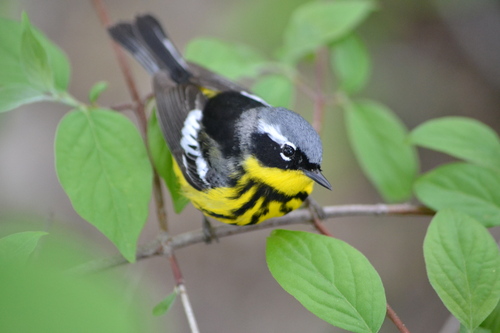
Magnolia Warbler
The Magnolia Warbler (*Setophaga magnolia*) is a small, vibrant songbird known for its striking black and yellow plumage and active foraging behavior. It plays a crucial role in controlling insect populations within its forest habitats. While not holding any specific, widely recognized cultural significance, it is a favorite among birdwatchers for its beauty and energetic displays. It is a neotropical migrant, breeding in North America and wintering in Central America and the Caribbean.
11-13 cm
Length
16-20 cm
Wingspan
Least Concern
Conservation Status
Distribution
Breeds across Canada and the northeastern United States, extending south in the Appalachian Mountains. Winters in Central America, from Mexico to Panama, and the Caribbean islands.
Lifespan
Typically up to 5 years in the wild, though the oldest recorded individual lived over 7 years.
Magnolia Warbler's Habitat
Habitat Types
Coniferous forests, Mixed woodlands, Young, dense forests, Forest edges
Climate Zones
Temperate, Boreal
Adaptations
Their preference for dense understory and lower canopy levels provides protection from predators and ample foraging opportunities for insects. Their agility allows them to maneuver through dense vegetation.
Variations
No widely recognized subspecies are currently identified, although slight variations in plumage may occur across its range.
Appearance
Breeding Plumage
Breeding males have bold black streaks on a bright yellow breast and belly, a black mask, and a gray crown. Females and non-breeding males are duller, with less distinct markings.
Seasonal Feather Changes
Plumage is brightest during the breeding season (spring and summer). In fall and winter, birds molt into a more subdued, non-breeding plumage.
Sex Based Plumage Differences
Males are more brightly colored than females, especially during the breeding season.
Notable Features
White wing bars, White tail spots (forming a distinctive band across the tail), Black necklace (streaking on the breast)
Diet and Feeding
Primary Foods
Insects, Spiders, Caterpillars, Beetles, Other arthropods
Foraging Behavior
Actively gleans insects from foliage, often hovering briefly to pick prey from the underside of leaves. They frequently flick their tails while foraging.
Specializations
Their small, pointed bills are well-suited for picking insects from leaves and crevices.
Seasonal Diet Variations
Primarily insectivorous during the breeding season. May consume some berries and fruits during migration and in wintering areas.
Behavior
Social Structure
Generally solitary or in pairs during the breeding season. May form small, mixed-species flocks during migration and on wintering grounds.
Communication
High-pitched, buzzy songs, Sharp 'chip' calls, Tail-flicking
Migration
Long-distance migrant. Travels at night, often in large groups. Migrates from North American breeding grounds to Central America and the Caribbean for winter.
Territorial or Group Behaviors
Males are territorial during the breeding season, defending their nesting areas from other males. They are less territorial during migration and on wintering grounds.
Conservation
Threats
Habitat loss (both breeding and wintering grounds), Collisions with buildings and windows, Climate change (potential shifts in habitat suitability), Pesticide use
Protection Programs
Bird-friendly building initiatives, Habitat conservation efforts
Local National Laws
Protected under the Migratory Bird Treaty Act in the United States and Canada.
Population Trend
Stable
Population Estimates
Global population estimated at around 39 million.
Interesting Facts
They are known for their characteristic tail-flicking behavior.
This is thought to startle insects, making them easier to catch.
The Magnolia Warbler was named by Alexander Wilson after a specimen he collected near a magnolia tree.
However, it is not particularly associated with magnolia trees.
Despite it is a long-distance migrant, it is only weigh about as much as a AAA battery.
This makes their long journeys even more impressive.
Faqs about Magnolia Warbler
What do Magnolia Warblers eat?
They primarily eat insects, spiders, and other arthropods, especially during the breeding season. They may also eat some fruits and berries during migration.
Where do Magnolia Warblers nest?
They typically build cup nests low in conifer trees or shrubs, often in dense, young forests.
Are Magnolia Warblers endangered?
No, they are currently listed as Least Concern by the IUCN, with a relatively stable population.
How can I attract Magnolia Warblers to my yard?
While they may pass through during migration, attracting them long-term is difficult unless you have suitable coniferous forest habitat. Providing a water source and avoiding pesticide use can help.
Copyright @ Nature Style Limited. All Rights Reserved.
 English
English